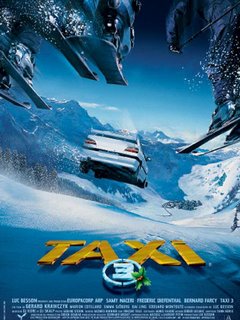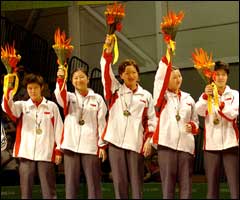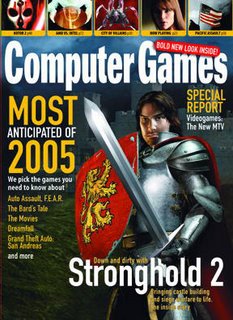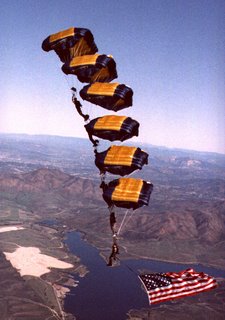Part II: China and India
SPEECH BY MINISTER MENTOR LEE KUAN YEW AT THE 37TH JAWAHARLAL NEHRU MEMORIAL LECTURE ON MONDAY, 21 NOVEMBER 2005, NEW DELHI INDIA IN AN ASIAN RENAISSANCE
.. I had been influenced by the ideas of the British Fabian society. But I soon realised that before distributing the pie I had first to bake it. So I departed from welfarism because it sapped a people’s self-reliance and their desire to excel and succeed. I also abandoned the model of industrialisation through import substitution. When most of the Third World was deeply suspicious of exploitation by western MNCs (multinational corporations), Singapore invited them in. They helped us grow, brought in technology and know-how, and raised productivity levels faster than any alternative strategy could.
The end of the Cold War and the collapse of the Soviet Union undercut the strategic premises of India's external and economic policies. By 1991, with the country on the verge of bankruptcy, India had no choice but to change. Some Indians believe that, had Rajiv Gandhi lived to serve a second term as India’s Prime Minister, he would have pushed for major reform. But he was cut down before he was able to.
It was left to PM Narasimha Rao to make the big move in 1991. Later that year, then Finance Minister Manmohan Singh and Commerce Minister Chidambaram gave a seminar in Singapore on India’s new policy of reform and opening up. In 1992,
Prime Minister Narasimha Rao met Singapor’s then Prime Minister Goh Chok Tong at the Non-Aligned Conference in Jakarta and persuaded him to visit India with a delegation of Singapore businessmen. PM Goh visited India from 23-30 January 1994 and
returned enthused.
In January 1996, I visited New Delhi and spoke to civil servants and businessmen on the changes that Prime Minister Rao and his team were putting into place. I said that India's 'tryst with destiny' had been repeatedly postponed.
When I published the second volume of my Memoirs in 2000, I wrote "India is a nation of unfulfilled greatness. Its potential has lain fallow, under-used." Time to Keep the Tryst
I am happy to now revise my view. Nehru's view of India's place in the world and of India as a global player is within India’s grasp.
Since 1991, India has changed governments from Congress to BJP to Janata Dal to BJP, and back again to Congress.
There have been six Prime Ministers. The pace of reforms has varied, but there has been no change in basic direction. The middle class has expanded. There is now no stigma in acquiring wealth . Indians have seen what market orientated policies have done for China and they do not want to be left behind.
The rise of India and China is changing the global balance. Together they account for about 40 percent of the world's working age population and 19 percent of the global economy in PPP (purchasing power parity) terms. On present trends, in 20 years, their collective share of the global economy will match their percentage of the global population, which is roughly where they were in the 18th Century, before European colonialism engulfed them. China’s and India’s trade, investments and other economic relations with the countries of East Asia and the Pacific are reshaping Asia’s economic geography. India is an important ASEAN Dialogue Partner, a member of the ASEAN Regional Forum, and an inaugural member of the East Asia Summit this December. And there is no reason why it should not join APEC (Asia -Pacific Economic Cooperation) after it has developed a thick web of economic ties across the Pacific.
East Asia is coalescing, brought together by market forces. India, China and Japan are readjusting their relationships with each other and with the US. This will not be an easy process because all countries want to preserve their independence and space to grow. If there are no mishaps by 2050 the US, China, India and Japan will be economic heavyweights , as will Russia if it converts its revenue from oil and gas into long term value in infrastructure and non-oil industries.
India is an intrinsic part of this unfolding new world order. India can no longer be dismissed as a "wounded civilisation", in the hurtful phrase of a westernised non-resident Indian author (V.S. Naipal). Instead, the western media, market analysts, and the International Financial Institutions now show-case India as a success story and the next big opportunity.
This is a comforting development for the US and the West, that a multi-party India is able to take off and keep pace with single-party China.
Forbes Asia recently reported that US venture firms will raise US$1 billion for India by the end of this year. India has emerged as a power in IT sector. It is the largest call-centre in the world. Almost half of the largest global corporates now do at least some of their back office work in India. Indian R&D centers of American technology firms are reported to file more patents than Bell Labs. This year, India announced more than 1,300 applications for drug patents, second only to the US and 25 percent more than Germany, way ahead of the UK and Japan.
The US is now courting a nuclear India as a strategic partner. The EU has also launched a strategic partnership with India, and Japan wants a global partnership with India. These are indices of India's growing weight in the world. Many countries, including Singapore, supported India's bid to be a Permanent Member of the UN Security Council. Nehru’s vision is within grasp and India’s leaders must realise it in the next few decades.
China and India
I have always taken a keen interest in both China and India. Like all democratic socialists of the 1950s, I tried to forecast which giant would make the higher grade. I had rather hoped it would be a democratic India. By the 1980s, however, I accepted that each had its strengths and weaknesses and that the final outcome would depend on their economic policies, the execution of those policies, the responsiveness of the government is to the needs of the people, and most of all the nature of the culture of the two civilisations.
Whether Asia will take its place in the world as Nehru wanted depends on how both India and China work together as they rise and actively set out to avoid ending up in opposing camps. It is vital that they understand where they stand vis-à-vis one another. They must not be paranoid and suspicious of each other in a game of one-upmanship. Instead they can cooperate and compete economically, and each improve it s performance by using the other’s progress as benchmarks for what they should do better.
India's bilateral relations with China have improved significantly in recent years after both sides decided to resolve long outstanding issues.
Compare and contrast: India & China
The world is fascinated by the renaissance of Asia’s two largest and most ancient civilisations and political and business leaders compare and contrast their progress and prospects.
At independence in 1947, two years before the Chinese Communist Party liberated China, India was ahead in many sectors. Both lost steam by adopting the planned economy. But because of its “great leap forward” and “Cultural Revolution”, China suffered more. However Deng Xiaoping was able to acknowledge China’s mistakes and China’s course dramatically change when he returned to power in 1978.
India has a superior private sector companies. China has the more efficient and decisive administrative system.
China has invested heavily in infrastructure. India underinvested infrastructure is woefully inadequate. India has a stronger banking system and capital markets than China. In dia has stronger institutions, in particular, a well developed legal system which should provide a better environment for the creation and protection of Intellectual Property. But a judicial backlog of an estimated 26 million
cases drags down the system. One former Indian Chief Justice of India’s Supreme Court has given a legal opinion in a foreign court that India's judicial system was practically non-functional in settling commercial disputes.
3
Both India and China have excellent universities, at the peak of their systems. India’s institutes of technology and management are world class. China is determined to upgrade its top 10 universities to world class status. Overall China's education system is more comprehensive. China’s illiteracy rate is below 10%, India’s about 40%. India’s narrower band of educated people will be a weakness in the longer term. And although top quality Indian manpower is in high demand, large numbers of engineers and graduates lack the skills required in a changing economy and remain unemployed. However India has a larger English speaking elite than China. But only over half of each Indian cohort completes primary school, a big loss.
After liberalisation, China and India have followed different models of development, maximising their respective strengths. China adopted the standard East Asian model, emphasising export-oriented manufacturing. China has been immensely more successful in attracting FDI. India has focused on IT and knowledge-based services. Job creation is much slower in India and will continue to remain so until India’s infras tructure is brought up to date to attract the many manufacturers who will come to use India’s low cost workers and efficient services.
China's GDP for manufacturing is 52%, India’s 27%; in agriculture China’s is 15%, India’s 22%; for services China’s 33%, India’s 51%. Over the last decade, in the service sector India has averaged 7.6% annual growth, China 8.8%, in manufacturing
India’s growth is 5.7%, China’s 12.8%.
India and China should co-operate and compete with each other, spurring one another to greater heights.
ASEAN will be a major beneficiary. As Senior Minister Goh Chok Tong once said, India and China can be the two wings of the jumbo jet for Southeast Asia.
India should benchmark itself not just against its own past, but against the best in Asia. And India can take heart from the achievements and performance of Non-Resident Indians (NRI) in free market economies such as the US, UK and even Singapore, where large numbers of NRIs have assumed high corporate positions in multi-national corporations.
Both India and China have both done much better than most of the world. In the decade from 1994 to 2004, India's
GDP grew two-fold from US$310 billion to US$661 billion. But during the same period, China's GDP grew three-fold from US$542 billion to US$1,649 billion. In 1984, India's GDP was about 30% smaller than China's. A decade later, it was more than 40% smaller and by 2004 it was about 60% smaller. Such a wide dispari ty is unnecessary. India can and should narrow the gap by embarking on a new round of reforms.
Walking on Two Legs
Can India keep pace with China’s growth? Yes, if India does more in those sectors where China has done better.
The Chinese are learning English with great enthusiasm, and are keen to develop a services sector like India's. All the leading Indian IT players are expanding in China, and training thousands of Chinese software programmers. One Indian company,Zensar Technologies Ltd, has been contracted to train 1,000 Chinese software project managers from Shenzhen in etiquette, communication and negotiation skills. Huawei, a leading Chinese technology company, has invested in Bangalore to tap its software skills. The Chinese want to reach international standards for the software outsourcing industry. They are not too proud to learn from India. In Dalian, Singapore is helping to develop an IT park which will be specifically marketed to Indian software companies interested in the Northeast Asian market.
But India cannot grow into a major economy on services alone . Since the industrial revolution, no country has become a major economy without becoming an industrial power.
Just as China is learning from India to improve its performance in the IT sector, so India must emulate China's success in attracting FDIs and the jobs they create in manufacturing. It can do this by building infrastructure and educating and raising the skill levels of its workers.
Arvind Panagariya, a professor of Indian political economy at Columbia University, USA, puts the issue clearly. He noted that some have argued that India can focus on IT, grow rapidly in services, skip industrialization, and yet transform itself from a primarily rural and agricultural country into a modern economy. He dismissed such ideas as "hopelessly flawed" and "far-fetched".
IT is less than 2% of India's GDP. While services have grown rapidly, the bulk of the growth is from service sectors where wages and productivity are low. Business services, which include software and IT-enabled services, account for only 0.3% of GDP. Only manufacturing can mop up India’s vast pool of unemployed, narrow the urban-rural divide and reduce poverty. Professor Panagariya concluded:
"The right strategy for India is to walk on two legs: traditional labour intensive industry and modern IT. Both legs need strengthening through further reforms ...."
India's relatively young population can be an asset if they are universally well educated. UN forecasts that India's population will outstrip China’s by 2030. Job creation through faster GDP growth is therefore an urgent necessity. Growth in IT and other services will not create enough jobs. IT-related jobs make up only one quarter of one percent of India's labour force.
To create jobs the main thrust of reforms must be in manufacturing. That requires a change in labour laws to allow employers to retrench workers when business demand is down , streamlining the judicial processes, reducing the fiscal deficit, loosening up the bureaucracy, and most of all improving infrastructure. Let me focus on the last two as I believe they are crucial and inter-connected.
Industrialisation cannot take off without adequate infras tructure: better roads, and a reliable supply of power and clean water, better ports and airports. By one estimate, economic losses from congestion and poor roads alone are as high as US$4
to 6 billion a year. Another estimate is that the cost of most infrastructure services in India is about 50% to 100% higher than in China. The average cost of electricity for manufacturing in India is about double that in China; railway transport costs in India are three times those in China. China has spent over eight times as much as India on its infrastructure. Three years ago, China's total
capital spending on electricity, construction, transportation, telecommunications and real estate was US$260 billion or more than 20 percent of its GDP as compared to US$31 billion or 8 percent of India’s GDP.
If there are budgetary constraints , the answer is to privatise these infrastructure projects. There are wellestablished construction companies, Japanese, Korean and others, that have done many such infrastructure projects on franchise terms.
One area where India has done well is its telecommunications infrastructure. This has been a critical factor for India’s IT success. India needs to aggressively priva tise infrastructure development and open it to foreign investment. Then FDI flows will increase. And the bureaucracy must not impose onerous conditions that will hamper this privatisation.
The Political and Economic Risk Consultancy (PERC) based in Hong Kong, recently surveyed expatriate businessmen on bureaucracy and red tape in Asia. India was rated worst out of the 12 countries covered. PERC's conclusion was that:
"The Government would like to liberalise many sectors, and there are plenty of announcements of new initiatives to do so. But when push comes to shove, bureaucratic inertia has been extremely difficult to overcome."
The World Bank has also done its own study. It found that in India it can take a decade to close a business through insolvency proceedings. It also found, among other things, that official fees amount to almost 13 percent of a property transaction in India as against just over 3 percent in China.
My secretaries asked Singapore businessmen with investments in India what, apart from infrastructure, they found as major constraints. To a man, they replied it was the bureaucracy.
They believe it is a mindset problem. The average Indian civil servant still sees himself primarily as a regulator and not as a facilitator. The average Indian bureaucrat has not yet accepted that it is not a sin to make profits and become rich . The average Indian bureaucrat has little trust in India’s business community. They view Indian businessmen as money grabbing opportunists who do not have the welfare of the country at heart; and all the more so if they are foreign businessmen. Deng Xiaoping said at the start of China’s open door policy, it was glorious to be rich. The sequel is reported in Forbes Asia, November 14 2005, where it listed over 300 China’s richest, 40 of them with thumbnail CVs in a centre -fold. All are new entrepreneurs creating jobs and spreading wealth. Now, after private enterprise and the free market have generated wealth in the coastal provinces, China’s leaders have concentrated on spreading growth to the inland provinces by building infrastructure and offering generous economic incentives for investments.
One Singapore businessman told me this story. He entertained a former senior Indian civil servant to lunch in Singapore. Some months later when he was in India, the former civil servant reciprocated by hosting a dinner at which several other guests were present. His host made this surprising comment that he was amazed to see that in Singapore, a business could be successful without being dishonest.
India must find some way to reward bureaucrats who facilitate , not hinder investments and enterprise whether Indian or foreign.
A factor worth noting: India gets a much better economic return for the investment it makes in its economy because India’s private sector capital efficiency is high. If India opens up fully to FDIs, the results will be profitable for the investor and add considerable employment and added GDP growth for India. With jobs there will be a trickle down of wealth to millions of Indian workers, as there has been in East Asia.
Politics is the Issue
What India has achieved since 1991 should not be underrated. There have been many successes. The Delhi Metro is one. Bharat Forge, the largest Indian exporter of auto components and the leading global chassis component manufacturer, is another example in the manufacturing sector. There are others. The question is why there are not many more of them?
There is no dearth of excellent analyses by Indians about th is problem. An entire library could be assembled on the subject. I consulted two books: The Future of India by Bimal Jalan, who was Governor of the Reserve Bank of India from 1997 to 2003, Chairman of the Economic Advisory Council to the Prime Minister and has represented India at the IMF and World Bank; one other book, Governance by Arun Shourie who has held several government portfolios and is a well-known writer. To sum up their arguments for the failings of the system in a single word: politics.
Earlier this year, Prime Minister Manmohan Singh gave a wide-ranging interview to the McKinsey Quarterly. He rated his own government's achievement as 6 out of 10, a performance he said was unsatisfactory. He acknowledged the need for better infrastructure, for more FDI, and also the need to move ahead in manufacturing. When asked whether the pace of implementation was fast enough, he replied:
" ... economic policy and decision making do not function in a political vacuum. It takes a lot of time for us to take
basic decisions. And furthermore, because we are a federal set-up, there are a lot of things that the central government does, but there are many things, like getting land, getting water, getting electricity - in all these matters the state government comes in, the local authority comes in ..... .... I do recognise that at times it gives our system the label that it is slow moving. In a world in which technology is changing at such a fast pace, where demand conditions change very fast, we need to look at a more innovative mechanism to cut down on this rigmarole of many tiers of decision-making processes."
Prime Minister Singh added, "We are a coalition government and that limits our options in some ways."
Politics is a fact of life in any country. And coalition politics is a fact of Indian political life.
It has been suggested that India's slow growth is the consequence of its democratic system of government. Almost 40 years ago, Professor Jagdish Bhagwati wrote that India may face a "cruel choice between rapid expansion and democratic processes".
But democracy should not be made an alibi for inertia. There are many examples of authoritarian governments whose economies have failed. There are as many examples of democratic governments who have achieved superior economic performance. The real issue is whether any country's political system, irrespective of whether it is democratic or authoritarian, can forge a consensus on the policies needed for the economy to grow and create jobs for all, and can ensure that these basic policies are implemented consistently without large leakage. India’s elite in politics, the media, the academia and think tanks can re-define the issues and recast the political debate. They should, for instance, insist on the provision of a much higher standard of municipal services.
By way of example, Chinese politics have always been plagued by factionalism. China also has great regional diversity. Like India, China also has powerful vested bureaucratic interests. But Deng Xiaoping forged a basic consensus among all political factions and the bureaucracy on the economic development and the necessary opening up to the outside world to succeed. A similar consensus can be achieved in India.
The passage of the Special Economic Zone (SEZ) Bill by the Lok Sabha (Lower House of the Indian Parliament) in May this year was an important move. SEZs can finesse some difficult internal issues blocking liberalisation. Singapore has some experience with SEZs in China. If India thinks it useful, we are willing to share our experiences with you, building upon what we have done in the Bangalore International Technology Park. I must conclude with a word of caution. SEZs, once embarked upon, must be made to succeed, which means total and sustained commitment from politicians and bureaucrats at national, state and local levels.
When they succeed, they will have a powerful effect on the whole economy, give a boost of confidence and spark off a healthy competitive dynamic between different states and regions. Successful SEZs also will erode opposition to reforms because their benefits become self-evident, as has happened in China.
A few months ago, in August, the communist Chief Minister of West Bengal was in Singapore to drum up investments for his state offering market incentives to attract investors. He said: “The lesson from the collapse of the Soviet Union and from China is that [India] must reform, perform or perish.” That very same month, members of his own party in Lok Sabha in New Delhi forced a retreat on India's privatisation programme. This is India’s party politics.
There are some imponderables. American commentators believe that China’s political system is too rigid, that it does not have the flexibility of pluralistic politics and democracy with freedom of speech, the media, assembly and respect for human rights.
So China will encounter severe problems and setbacks. Professor Pranab Bardhan1 of University of California, Berkeley, has explained
the problem this way:
“China's authoritarian system of government will likely be a major economic liability in the long run, regardless of its immediate implications for short-run policy decisions.
“But inequalities (particularly rural-urban) have been increasing in China, and those left behind are getting restive.
With massive layoffs in the rust-belt provinces, arbitrary local levies on farmers, pervasive official corruption, and toxic industrial dumping, many in the countryside are highly agitated.
“China is far behind India in the ability to politically manage conflicts, and this may prove to be China's Achilles' Heel.
Over the last fifty years, India's extremely heterogeneous society has been riddled with various kinds of conflicts,but the system has by and large managed these conflicts and kept them within moderate bounds. For many centuries, the homogenizing tradition of Chinese high culture, language, and bureaucracy has not given much scope
to pluralism and diversity, and a centralizing, authoritarian Communist Party has carried on with this tradition”.
Pranab Bardhan is Professor of Economics at the University of California, Berkeley and co-chair of the MacArthur Foundation-funded
Network on the Effects of Inequality on Economic Performance and Chief Editor of the Journal of Development Economics.
6
If they are right, India will draw ahead in the longer term.
Such analyses assume that the Chinese political system will remain static. If China’s political structures do not adjust to accommodate the changes in its society resulting from high rates of growth, India will have an advantage because of its more flexible political system in the longer term.
But Bardhan also cautions: “India’s reform has been halting and hesitant. India’s heterogeneous society has been riddled with conflicts, but the system has by and large managed these. There are many severe pitfalls and roadblocks which India and China have to overcome.”
Both India and China are huge countries with vast populations and long histories. They have to evolve standards of governance that is consonant with their cultures and the spirit of their civilisations.
At stake is the future of one billion Indians. India must make up for much time lost. There is in fact already a strong political consensus between India’s two major parties that India needs to liberalise its economy and engage with the dynamic economies of the world. The BJP led coalition government of former PM Atal Behari Vajpayee continued and indeed extended the economic libera lisa tion policies of Manmohan Singh when he was Finance Minister in PM Narashima Rao’s government. India now has a strong, able and experienced team wi th Manmohan Singh as PM. The time has come for India's next tryst with destiny.
Friday, March 31, 2006
Thursday, March 30, 2006
make yourself relevant
MM Lee in his Q & A Session at NTU Students' Union (9th Ministerial Forum) at Nanyang Auditorium on 18 February 2003, said that :
"..we have to become a cosmopolitan city which is linked up to China, to India, to the region and to the world beyond.
In other words, if we confine ourselves only to Singapore -- localisation --
then we'll go back to the fishing village from whence we sprang, and there are only 120 people who could live off Singapore, and I wonder if we can even support our 120 people because we have destroyed all the fishing grounds around us.
So there is no choice but to move forward and there is no choice for the rest of the world too, because as you build on your discoveries -- scientific, technological, discovery of other countries, you find you can improve your standard of living, your quality of life by exchanging goods, products, services.
"Now, when that came to an end suddenly in Japanese-occupied Singapore, because their ships were being sunk by Allied submarines, Singapore just shrunk.
There were no medicines, no textiles, we took tablecloth and turned them into trousers and shirts. No rice because rice was imported from Thailand and even the junks were being sunk and we started planting tapioca and sweet potatoes and lived a very unhealthy life.
So it was a lesson to me in very practical terms of what it means by that simple concept -- division of labour.
"The world has achieved this standard of living and large parts of the world are enjoying a standard of life never before ever enjoyed in its history because advances made by certain groups in certain countries rapidly improved the well-being of others.
So somebody discovers a drug to solve, let's say, Alzheimer or Aids. First to benefit will be the drug company to recover part of its R&D and to give profits so that other people will invest in other pharmaceutical companies to continue more research, but eventually, the whole world benefits. So whether it is us or any other country, there is no choice but to plug in into what is going on in the most developed places and hoist in the benefits.
"After the war, it was fashionable for many newly independent countries to try and become self-sufficient. There were several theories around at that time advanced by Latin American economies to say that if you allow these multinationals in, you're being exploited by them, they exploit your natural resources, your labour and so on, and you are then impoverished.
So, they started trying to own their own steel mills, their own petrochemicals et cetera, and they did not succeed. We tried that route and made our own toothpaste, mosquito sticks and a few other simple products and decided if we continued along that path, we would all die of starvation.
"So we decided, let's do the practical thing. If this company is the world champion in this product, it's going to beat other companies, well, let's get them here, 100 per cent owned by them, they make use of us, we educated our people who became factory floor operators, then supervisors, then accountants, then managers, engineers and that's how we got here.
By the late 1970s, the others around the region decided that we were right and they started copying us.
Now, China has decided, yes, it is right, so they are sucking in all the investments that's coming to East Asia -- 70 per cent of all the investments coming to East Asia now is going into China -- and it's the fastest way to learn to develop your own capabilities and your infrastructure and later on, the capital to buy more machines and invent new ones.
So, whether it's localisation, regionalisation or globalisation, you come back to, how many links can you forge with the rest of the world and make yourself relevant to the most number of people in this world, and if you do that, you'll succeed."
Note:
The things MM Lee said meant something, although some may not like his style. There are something we could learn from the history of yesterday and applied ourselves in the new economy, beyong 2000's: stay relevant or be obsolete.
In the end,we have only two choice, and time is not on our side as we are aging nations. We needed to sprint to stay ahead, a step of ahead of others. There are price to pay. There are always equilibrium: you have to return what you take from others.
"..we have to become a cosmopolitan city which is linked up to China, to India, to the region and to the world beyond.
In other words, if we confine ourselves only to Singapore -- localisation --
then we'll go back to the fishing village from whence we sprang, and there are only 120 people who could live off Singapore, and I wonder if we can even support our 120 people because we have destroyed all the fishing grounds around us.
So there is no choice but to move forward and there is no choice for the rest of the world too, because as you build on your discoveries -- scientific, technological, discovery of other countries, you find you can improve your standard of living, your quality of life by exchanging goods, products, services.
"Now, when that came to an end suddenly in Japanese-occupied Singapore, because their ships were being sunk by Allied submarines, Singapore just shrunk.
There were no medicines, no textiles, we took tablecloth and turned them into trousers and shirts. No rice because rice was imported from Thailand and even the junks were being sunk and we started planting tapioca and sweet potatoes and lived a very unhealthy life.
So it was a lesson to me in very practical terms of what it means by that simple concept -- division of labour.
"The world has achieved this standard of living and large parts of the world are enjoying a standard of life never before ever enjoyed in its history because advances made by certain groups in certain countries rapidly improved the well-being of others.
So somebody discovers a drug to solve, let's say, Alzheimer or Aids. First to benefit will be the drug company to recover part of its R&D and to give profits so that other people will invest in other pharmaceutical companies to continue more research, but eventually, the whole world benefits. So whether it is us or any other country, there is no choice but to plug in into what is going on in the most developed places and hoist in the benefits.
"After the war, it was fashionable for many newly independent countries to try and become self-sufficient. There were several theories around at that time advanced by Latin American economies to say that if you allow these multinationals in, you're being exploited by them, they exploit your natural resources, your labour and so on, and you are then impoverished.
So, they started trying to own their own steel mills, their own petrochemicals et cetera, and they did not succeed. We tried that route and made our own toothpaste, mosquito sticks and a few other simple products and decided if we continued along that path, we would all die of starvation.
"So we decided, let's do the practical thing. If this company is the world champion in this product, it's going to beat other companies, well, let's get them here, 100 per cent owned by them, they make use of us, we educated our people who became factory floor operators, then supervisors, then accountants, then managers, engineers and that's how we got here.
By the late 1970s, the others around the region decided that we were right and they started copying us.
Now, China has decided, yes, it is right, so they are sucking in all the investments that's coming to East Asia -- 70 per cent of all the investments coming to East Asia now is going into China -- and it's the fastest way to learn to develop your own capabilities and your infrastructure and later on, the capital to buy more machines and invent new ones.
So, whether it's localisation, regionalisation or globalisation, you come back to, how many links can you forge with the rest of the world and make yourself relevant to the most number of people in this world, and if you do that, you'll succeed."
Note:
The things MM Lee said meant something, although some may not like his style. There are something we could learn from the history of yesterday and applied ourselves in the new economy, beyong 2000's: stay relevant or be obsolete.
In the end,we have only two choice, and time is not on our side as we are aging nations. We needed to sprint to stay ahead, a step of ahead of others. There are price to pay. There are always equilibrium: you have to return what you take from others.
Wednesday, March 29, 2006
the line of death

I used to jog in the evening as it was cooler and you could smell the fesh fragnance of the trees and flowers along the path.
To me every jog was a special as I treasured each jog as a fresh and renewing day for me.
Little do I expected a close shave and a thin line between live and death.
I was jogging along a path when I saw many people walking on the pavement, so I took the side of the road, where I jogged the double-yellow lines. Just I started running, a double-decker droved by and I could felt the turbulence of the wind.
The bus-driver slowed and I waved my apologies, and he understood, and continued on.
I knew that I have just escape the line of death.
Tuesday, March 28, 2006
Hawker Centres Upgrading Programme Part II
Just find out from the HDB website that HUP for Jurong East St 24 was awarded to TEW KIM THAI CONSTRUCTION PTE LTD at contract sum of S$4,160,000.00 on 6th June 2005.
They have the lowest tender quotation. The ranges from a S$4,160,000.00 to S$5,743,800.00. Only slightest difference between the first and second lowest quotation, but 1,583,800.00 between the highest and lowest bid.
Bearing in mind, the rental will be increased for Cooked food from S$160 to new rental ranging S$320 -S$480 (100%-200% increase) per month. For existing rental for wet market ranging of S$56 - S$92, it will revised upwards to S$112 - S$276. (100%-200% increase.).
we will be expecting prices of consumed food to increase after the hawker centre to open. (if it can in time.)
That was one of the reasons of our cost of living is increasing.
Would it better not to upgrade or re-configured or Re-built Centres? Only time will tell. But I hope it will be delayed another 3 months or even more.
They have the lowest tender quotation. The ranges from a S$4,160,000.00 to S$5,743,800.00. Only slightest difference between the first and second lowest quotation, but 1,583,800.00 between the highest and lowest bid.
Bearing in mind, the rental will be increased for Cooked food from S$160 to new rental ranging S$320 -S$480 (100%-200% increase) per month. For existing rental for wet market ranging of S$56 - S$92, it will revised upwards to S$112 - S$276. (100%-200% increase.).
we will be expecting prices of consumed food to increase after the hawker centre to open. (if it can in time.)
That was one of the reasons of our cost of living is increasing.
Would it better not to upgrade or re-configured or Re-built Centres? Only time will tell. But I hope it will be delayed another 3 months or even more.
Monday, March 27, 2006
a close shave

one of my friends used to work in Pasir Panjang Wholesale Centre. Since he has found a new job, he left a few weeks ago.
Then he was alarmed to read the new about the building at Pasir Panjang Wholesale Centre was closed temporarily after gas leak. He has worked there for quite a few years and everything seemed fine before he left. And he used to work for the building that gas has leaked.
Wow. I told him he was fortunate to escape the accident and still in one-piece.
I told him that the exposure to more concentrated levels of ammonia gas (above 25 ppm) can cause headaches, nausea, and intense burning of the eyes, nose, throat, and skin. So, it was not a good environment to work.
Well, for him it was a very close shave indeed. He lived again.
Sunday, March 26, 2006
The cost of owning a car

heard from radio, there are 12 cost factors:
1. depreciation.
2. COE
3. Insurances
4. Economical cost
5. accidents cost
6. cash (such as car-washing)
7. Parking fees
8. ERP/CTE(Every Road Pay/Cut-throat Expressway)
9. Fines
10.Petrol
11. Maintenence cost
12. Road Tax
Also, was informed for every cc of car you have to pay $1.00 per month.
That meant if you want to own a 1000cc car, you needed to spent S$1000 per month. If you are driving a 2000cc's car, then you have to fork out at least S$2000 from your monthly salary.
So, do not envy those who drove a car, they have throw that kind of cash for their cars. Not forgetting for those who bought COE at much higher price, (some of my friend did and have to pay the higher same car loan) and they stand to lose at S$10,000-S$20,000 should they want to change new car and they lost twice just by
selling and buying a new car.(double whampy)
For those who earned $10,000 or even more (managers, directors), they will have no problems. (for your information, university professor are earning at least S$10,000 per month)
For those take taxis to and fro, they need not to spend S$1000 monthly. A wise choice and needed not worry too much on maintenance, rising petrol, ERP,etc)
For comparison, let say a person earning S3,000 per month. deducting off his CPF, he is left with S$2,400. If the person is driving 1,600 cc car, his actual cash for the month is S800 for himself and family (if he has).
Saturday, March 25, 2006
taxi

Like many others, I also hold taxi vacational licence.
Like many others, we used it as the last retort for emergency cases.
However,when I spoke to one of my friends who has worked full-time as taxi-drivers, I was surprised to hear that tax-driver was a tough job, and told me to forget the idea of becoming one.
The main cause: the customers. whether you make in shortest time or short path, they still asked for discount. My friend always gave way.
However, there are certain advantage: you decided your working hours, and half way through working, you can take a break and go shopping.
Friday, March 24, 2006
shop house cum living quaters

Recently, we have noticed something fishy going on on a shop house of a particular block.
Previously, it was a provision shop and because of poor business, it was closed down last year. Over the past month, the roller shutter was being lowered down and we assumed that the unit was being letting out and undergoing renovation.
However, after few observations, we noticed many strangers, namely workers entering through the back gate at late evening via truck, leaving early in the morning, clothes were seen hanging inside and outside the shop and people are bathing. They occupied the second level of the same unit as well.
Wondered what has happened...
Thursday, March 23, 2006
Time Machine

HG Wells (1866-1946)
The Time Machine was first published in 1894, it was brought out as a book the next year under its current name and sold more than six thousand copies in a few months.
He was just twenty-seven-years-old then.
I liked the novel's appeal lies in its attempt to tell us what will become of human beings in the distant future as we could not see the future in 100-200 years' time.
it make the central character of a time traveler who can transport himself back and forth in time with the aid of a machine he invented, he is able to explore many of the themes that obsessed him, including evolution, and the fantasy of time journey, where he can roam the world forever.
He described the future world of the effete Eloi and the cannibalistic Morlocks and the world beyond that in which all semblance of human life has been erased,
He illustrates what he believes may very well be the fate of humanity.
Wednesday, March 22, 2006
Hawker Centres Upgrading Programme

Our hawker centre cum wet market at Jurong East was closed for HUP from July 2005 and to be completed by April 2006.
From the day one till this year January, we only could see less workers and supervisors working(around 10-20), work done such the roof being hacked away and new rubbish centre.
After the Lunar New Year, as the days drew nearer to completion day, then there was a lot of activities. Sub-contractors from main contractor's were being called to rush to complete. They have only two months' time.
There are still alot of work to be done: tiling, rewiring,new roof, painting. The list can goes on and on..
Wondered whether they can handover to the HDB on time.
Note: The upgrading is mainly designed to improve the facilities, especially ventilation, at the hawker centres. Standard upgrading included re-tiling, replacement of tables and stools as well as improvement in facade, roofing, electrical, exhaust and plumbing systems. The toilets and bin centres will also be upgraded. Reconfiguration or rebuilding included extensive work will be carried out to redesign the layout, incorporating additional fire safety features and, where possible, the stalls will be made larger.
Tuesday, March 21, 2006
patience

Have watched the ladies table tennis final at Melboure in Australia. The most exciting was the last match between Sharon Tan and Jian Fang Lay.
Sharon Tan showed great patience at the last nail-biting game 5 and waiting for the Jian to make the mistakes and won.
She could have smashed for the last 2 points but she waited, and waited. And much to her relief, Jian was over anxious and made mistakes and the rest is history.
Monday, March 20, 2006
singapore serf
Have read the blog from singaporeserf.
He has started to blog again.
Think Michael Chua has left his first comments on his eight post on September 2004.
that was one and half years ago. Time really flies.
He has started to blog again.
Think Michael Chua has left his first comments on his eight post on September 2004.
that was one and half years ago. Time really flies.
Sunday, March 19, 2006
helpless

There are times when you felt helpless.
You wanted to do something, but could not do so because of something else. You felt stuck and hanging in the air. As days dragged by, if you thought too much, you would feel miserable. May be, I assumed that it was part of your life.
So, as you get older, you will place them at one side and continued on your life as usual.
Well, that is life, isn't it.
Saturday, March 18, 2006
durians

Last year, my friend told me that there are some durian plantation at Bukit Batok West Ave 5. We took the bus, and found the place. Nearby there was a primary school, HongKah Primary School, and the durian plantation was in Restricted Area.
I saw many people walking through a small track and we followed, and walked for 10 minutes and saw many durian trees. Some are waiting at below the tree, waiting for the durians to fall. Heard from them that if you pluck the durians, it was not so good as it has not ripe yet. The best one is that the durian falls to the ground and is confirmed ripe.
We waited and managed to get a few and placed them inside plastic bag, and went home.
Using a knife, i opened, and scoped with spoon and placed onto a plate, and passed around with my friends to eat.
It was delicious and it melt in your mouth. The taste was fantastic, as it was freshly-picked.
Yummy..heavenly taste!!
Not forgetting the rumbutan trees nearby. We plucked a pastic full and ate to our fill.
Friday, March 17, 2006
Park

Normally, if I have the time, I will have a stroll at the park nearby our Hdb flat for half an hour or so.
It was on old park as we have lived in the same area for over 20 over years. so, the trees have grown to much taller, and provided much shade, making the place cooler and more greener. Recently, as some of the trees are old, they are chopped down for safety reasons.
I usually brought along a radio with ear phone and walked along the jogging paths, where I could young and old joggers, male or female prospired as they ran past me. When I walked a bit tired, I sat down on the wooden bench, and listened to the radio broadcast.
As the wind blows, the sound of leaves rustling, and here I am, listening to favorite songs and doing nothing, it was sheer enjoyment off the stress of the work.
Thursday, March 16, 2006
Bloodbank@HSA

I have donated blood a few times from 1991 till now.
Mostly of the time, I went to National Blood Centre (NBC) at Outram Park. The blood Centre opened in 1988.
Sometimes, I travelled to NUH (National University Hospital)
On 1 April 2001, when the Health Sciences Authority (HSA) was established, the Singapore Blood Transfusion Service was renamed as what we know today as the Centre for Transfusion Medicine, one of the 8 professional centres of HSA.
Now the centre is now known as the Bloodbank@HSA.
Over the years, I have changes in the nursing Service Officers or assistant Nurses.(they have changed the name of staff nurse to nursing service officer,that's something new)
From the old type of white uniform to presently yellow top with dark blue skirt, they have come a long way.
Also, the nationality of nurses change as well. From Malaysian or Singaporean to Myanmar and back to Singaporeans.
Well, life still goes on as usual.
Wednesday, March 15, 2006
world cup 2006

85 days to go!! have to quickly buy DVD recorder to record the exciting matches..
and not forgetting the Korean drama at Channel U at 2200 hrs
Tuesday, March 14, 2006
free computer games

I usually download some computer games for my sister's son and daughters to play when they came to visit.
Lately when i was defragmenting the harddisk, I have problems in doing do. The system always prompts me that there was scandisk error and I have already scanned
Tried many times and it was still the same problems.
That led me to no alterative but to uninstall the games, reinstall the Operating system, that I managed to defragment.
It seemed that the games have corrupted my orginal system setting.
Wow. Next time not to download any things that was free.
Monday, March 13, 2006
down with work

time reallies flies, and it has been 6 days i have blogged.
my apologies to all.
have been "sky-diving" with the US team. the last person in the picture was me lah.
Sunday, March 12, 2006
10 years trend for job market (a rough look)
On 2 Jan 1992, Dr Lee Boon Yang relinquished his posts as Minister in the Prime Minister's Office and took on the appointment of Minister for Labour, retaining his portfolio as Second Minister for Defence. On 12 May 2003, he relinquished the Manpower portfolio to serve as the Minster for Information, Communications and the Arts.
Dr Ng Eng Hen was Minister of State, Education and Manpower in 2002. He took over Acting Minister for Manpower on 12 May 2003. Then on 12 Aug 2004, he became Minister for Manpower & Second Minister for Education and on 1 July 2005, he was Minister for Manpower & Second Minister for Defence.
From Labour Market 2005, if we deduct 10% for PR from Singaporean of the overall table, and added to foreigners, we could see the 10 years trends in Sinapore.
Over the period from 1995 to 2005, slightly more than 50% of the jobs goes to Singaporean(excluding PR) and 50% goes to foreigners. The latter tended to concentrate in construction industry and also manufacturing industry. The reasons mainly due to tough work environments and 8 or 12 hours shift rotation.
From the table, we could see more foreigner entering in the job market from 1995 to 2001(under Dr Lee Boon Yang), but lesser from 2002 to 2005.(under Dr Ng Eng Hen).
Dr Ng Eng Hen was Minister of State, Education and Manpower in 2002. He took over Acting Minister for Manpower on 12 May 2003. Then on 12 Aug 2004, he became Minister for Manpower & Second Minister for Education and on 1 July 2005, he was Minister for Manpower & Second Minister for Defence.
From Labour Market 2005, if we deduct 10% for PR from Singaporean of the overall table, and added to foreigners, we could see the 10 years trends in Sinapore.
Over the period from 1995 to 2005, slightly more than 50% of the jobs goes to Singaporean(excluding PR) and 50% goes to foreigners. The latter tended to concentrate in construction industry and also manufacturing industry. The reasons mainly due to tough work environments and 8 or 12 hours shift rotation.
From the table, we could see more foreigner entering in the job market from 1995 to 2001(under Dr Lee Boon Yang), but lesser from 2002 to 2005.(under Dr Ng Eng Hen).
Thursday, March 09, 2006
wolf

recently there are two movies regarding wolf, one was "wolf creek" and the other,"cry wolf".
although they shared the same "wolf", the story unfolded in a differently prospective. one was about a chilling, factually-based, story of three road-trippers in remote Australia who are plunged into danger when they accept help from a friendly localand the other about eight unsuspecting high school seniors at a boarding school, who delight themselves on playing games of lies, come face-to-face with terror and learn that nobody believes a liar - even when they're telling the truth.
the truth :-
Wolves belong to family groups called packs, they usually consist of eight to fifteen-members. The rare exception is what is popularly know as a "lone wolf", this wolf would most likely be the lowest member of a pack (the omega) that was driven out of the pack, if it is lucky, the "lone wolf" may find a mate and start a new pack. Wolf packs can have very large range (6 to 600 miles)
The alpha pair has the greatest amount of social freedom among all the pack members, but they are not "leaders" in the human sense of the term. The alphas do not give the other wolves orders; rather, they simply have the most freedom in choosing where to go, what to do, and when to do it. The rest of the pack usually follows. There are various subordinates, who dominate the omega. The omega is the lowest. It is the baby-sitter and usually more puppy than wolf.
In larger packs, there may be also be a beta wolf or wolves - a "second-in-command" to the alphas. In addition, one wolf typically assumes the role of omega, the lowest-ranking member of a pack. These individuals absorb the greatest amount of aggression from the rest of the pack, and consequently enjoy comparatively few individual privileges.
While most alpha pairs are monogamous with each other, there are exceptions. An alpha animal may preferentially mate with a lower-ranking animal, especially if the other alpha is closely related (a brother or sister, for example). The death of one alpha does not affect the status of the other alpha, who will quickly take another mate. Usually, only the alpha pair is able to successfully rear a litter of pups (other wolves in a pack may breed, and may even produce pups, but usually they lack the freedom or the resources to raise the pups to maturity). All the wolves in the pack assist in raising wolf pups. Some mature individuals, usually females, may choose to stay in the original pack so as to reinforce it and help rear more pups. Most, males particularly, will disperse, however.

Rank order is established and maintained through a series of ritualized fights and posturing best described as ritual bluffing. Wolves prefer psychological warfare to physical confrontations, meaning that high-ranking status is based more on personality or attitude than on size or physical strength. Rank, who holds it, and how it is enforced varies widely between packs and between individual animals. In large packs full of easygoing wolves, or in a group of juvenile wolves, rank order may shift almost constantly, or even be circular (e.g., animal A dominates animal B, who dominates animal C, who dominates animal A).
Loss of rank can happen gradually or suddenly. An older wolf may simply choose to give way when an ambitious challenger presents itself, yielding its position without bloodshed. On the other hand, the challenged individual may choose to fight back, with varying degrees of intensity. While the majority of wolf aggression is non-damaging and ritualized, a high-stakes fight can easily result in injury for either or both parties. The loser of such a confrontation is frequently chased away from the pack or, rarely, may be killed as other aggressive wolves contribute to the insurgency. This kind of dominance encounter is more common in the winter months, when mating occurs.
Wolves will defend there territory, they work as a pack to harass larger animals like bears, although a pack of 12 were once known to kill a grizzly bear, most times if the animal runs away the wolves will not attack.
Animals the wolf may come in contact with are:
Coyotes - They will avoid wolves most times. but when encounters occur they are aggressive.
Grizzly bears - Are known to eat wolf pups, wolves will chase away bears from the den area.
Cougars - Although rare in nature, the cougar being a lone hunter is at a disadvantage in a fight with a wolf pack.
Foxes - Foxes have been observed stealing from wolf kills, wolves have been know to steal fox dens, wolves have been known to kill foxes, though it is rare, more often than not they ignore these tiny predators, the exceptions is in the arctic region where wolves will usually kill a fox on sight.
Ravens - One of the most fascinating relationships between animals is the one that seems to exist between wolves and raven. The raven, scavenger of food of all types, will often follow wolf packs in hopes of morsels of food. and wolves have learned to watch for circling ravens as a sign of possible food below.
Dogs - Although wolves are physiologically capable of breeding with dogs, such crossed usually happen in captive situations, trappers tales of wild wolves mating with dogs is usually a campfire myth. Most encounters between wild wolves and dogs are aggressive in nature, it is only natural a dog would be a trespasser in a wolf's territory, small yapping dogs may be attacked as nuisances.
Communication
Body Postures
Wolves communicate not only by sound (such as yipping, growling, and howling), but also by body language. This ranges from subtle signals-such as a slight shift in weight-to the obvious, like rolling on the back as a sign of submission.
Here are some other examples of Body postures:
Dominance - A dominant wolf stands stiff legged and tall. The ears are erect and forward, and the hackles bristle slightly. Often the tail is held vertical and curled toward the back. This display shows the wolf's rank to all others in the pack. A dominant lupine may stare penetratingly at a submissive one, pin it to the ground, "ride up" on its shoulders, or even stand on its hind legs.
Submission (active) - In active submission, the entire body is lowered, and the lips and ears are drawn back. Sometimes active submission is accompanied by a rapid thrusting out of the tongue and lowering of the hindquarters. The tail is placed down, or halfway or fully between the legs, and the muzzle often points up to the more dominant animal. The back may be partially arched as the submissive wolf humbles itself to its superior. (A more arched back and more tucked tail indicate a greater level of submission.)
Submission (passive) - Passive submission is more intense than active submission. The wolf rolls on its back and exposes its vulnerable throat and underside. The paws are drawn into the body. This is often accompanied by whimpering.
Anger - An angry lupine's ears are erect, and its fur bristles. The lips may curl up or pull back, and the incisors are displayed. The wolf may also snarl.
Fear - A frightened wolf tries to make its body look small and therefore less conspicuous. The ears flatten down against the head, and the tail may be tucked between the legs, as with a submissive wolf. There may also be whimpering or barks of fear, and the wolf may arch its back. Defensive - A defensive wolf flattens its ears against its head.
Aggression - An aggressive wolf snarls and its fur bristles. The wolf may crouch, ready to attack if necessary.
Suspicion - Pulling back of the ears shows a lupine is suspicious. In addition, the wolf narrows its eyes. The tail of a wolf that senses danger points straight out, parallel to the ground.
Relaxedness - A relaxed wolf's tail points straight down, and the wolf may rest sphinxlike or on its side. The wolf's tail may also wag. The further down the tail droops, the more relaxed the wolf is. Tension - An aroused wolf's tail points straight out, and the wolf may crouch as if ready to spring.
Happiness - As dogs do, a lupine may wag its tail if it is in a joyful mood. The tongue may loll out of the mouth.
Hunting - A wolf that is hunting is tensed, and therefore the tail is horizontal and straight.
Playfulness - A playful lupine holds its tail high and wags it. The wolf may frolic and dance around, or bow by placing the front of its body down to the ground, while holding the rear high, sometimes wagged. This is reminiscent of the playful behavior executed in domestic dogs.
Communication through Scent
Wolves have a very good sense of smell Research shows wolves have been able to detect their pray at distances of up to 1.75 miles (3 kilometers), which they also use to communicate. Wolves mark their territory with urine and faeces. This is called scent marking. When "outside" wolves smell this, they know that an area is already occupied. Of course, their sense of smell also tells them when food or enemies are near.
Communication through Sound - the wolf howl
Wolves howl for several reasons. Howling helps pack members keep in touch, allowing them to effectively communicate in thickly forested areas or over great distances. Furthermore, howling helps to summon pack members to a specific location. Howling can also serve as a declaration of territory, as portrayed by a dominant wolf's tendency to respond to a human imitation of a "rival" individual in an area that the wolf considers its own. This behavior is also stimulated when a pack has something to protect, such as a fresh kill. As a rule of thumb, large packs will more readily draw attention to themselves than will smaller packs. Adjacent packs may respond to each others' howls, which can mean trouble for the smaller of the two. Thus, wolves tend to howl with great care.
Wolves will also howl for communal reasons. Some scientists speculate that such group sessions strengthen the wolves' social bonds and camaraderie -- similar to community singing among humans. During such choral sessions, wolves will howl at different tones and varying pitches, which tends to prevent a listener from accurately estimating the number of wolves involved. This concealment of numbers makes a listening rival pack wary of what action to take. For example, confrontation could mean bad news if the rival pack gravely underestimates the howling pack's numbers.
Observations of wolf packs suggest that howling occurs most often during the twilight hours, preceding the adults' departure to the hunt and following their return. Studies also show that wolves howl more frequently during the breeding season and subsequent rearing process. The pups themselves begin howling towards the end of July, and can be provoked into howling sessions relatively easily over the following two months. Such indiscriminate howling usually has a communicative intent, and has no adverse consequences so early in a wolf's life. Howling becomes less indiscriminate as wolves learn to distinguish howling pack members from rival wolves.

Far across the tanana, a mile or two to the south of us, a group of wolves were singing. I call it singing, not howling, for that is what it was like. We could distinguish three, perhaps four voices - wavering, ascending in pitch, each one following the other, until they all broke off in a confused chorus. Their voices sank into distant echoes on the frozen river, and began again. A light and uncertain wind was blowing out there, and the sound grew and faded as the air brought it toward us or carried it away southward. It might have come across a thousand years of ice and wind-packed snow, traveling as the light of the stars from a source no longer there.
Monday, March 06, 2006
primary school
i remembered I studied in primary school. A relatively old school which started in 1876 as Singapore Chinese Branch School at upper cross street. It had ceased operations at its Pearl's Hill site on 31 Dec 2001.
I remembered most because we have to queue up to take the lift, it was a big lift, lke cargo lift which took us to various floor. I heard that it was one of the tallest primary school in singapore, and to have lifts installed.
It was situated at Pearl's hill and hence its name, Pearl's Hill School.
Nearby, there was a pearls' hill City Park which one of the reservoir's catchments was located at its top, guard by the police. It was a 5 minutes walk from Outram MRT
I searched through the internet but could not find images for the school.So, no pictures.
i remembered the most because i was being craned as i was once a naughty and mischevious boy. The school was strict.
Although it was strict, we still enjoyed the studies. I have a old classmates who came from the same primary school and still have contact with him.
When i went back one day recently, i was surprised that it has closed down and coverted to hostel for foreign students. Later it was closed down and left vacant till this day. Wondered what will happened next.
I could see the clothes hanging at their windows and air-con being installed each level. Students, mostly from China were seen in their rooms. They were quite young, around teenagers.
Before that, parents were seen at the exit of the school, waiting for their sons and daughters. They sat the long bench, chit-chating the lastest hot news around the town.
The Pearl's Hill City Park used to have many joggers, mostly much older mens and women in its park.(they were good, some could really jogged for an hour and the path was steep, with many steep and longstaircases). But it has changed into night-spot. One could see tissue papers aorund the benches.
well, that was then. memories are just memories. It came and gone. By the next century, I will be gone as well.
I remembered most because we have to queue up to take the lift, it was a big lift, lke cargo lift which took us to various floor. I heard that it was one of the tallest primary school in singapore, and to have lifts installed.
It was situated at Pearl's hill and hence its name, Pearl's Hill School.
Nearby, there was a pearls' hill City Park which one of the reservoir's catchments was located at its top, guard by the police. It was a 5 minutes walk from Outram MRT
I searched through the internet but could not find images for the school.So, no pictures.
i remembered the most because i was being craned as i was once a naughty and mischevious boy. The school was strict.
Although it was strict, we still enjoyed the studies. I have a old classmates who came from the same primary school and still have contact with him.
When i went back one day recently, i was surprised that it has closed down and coverted to hostel for foreign students. Later it was closed down and left vacant till this day. Wondered what will happened next.
I could see the clothes hanging at their windows and air-con being installed each level. Students, mostly from China were seen in their rooms. They were quite young, around teenagers.
Before that, parents were seen at the exit of the school, waiting for their sons and daughters. They sat the long bench, chit-chating the lastest hot news around the town.
The Pearl's Hill City Park used to have many joggers, mostly much older mens and women in its park.(they were good, some could really jogged for an hour and the path was steep, with many steep and longstaircases). But it has changed into night-spot. One could see tissue papers aorund the benches.
well, that was then. memories are just memories. It came and gone. By the next century, I will be gone as well.
Saturday, March 04, 2006
Friday, March 03, 2006
Thursday, March 02, 2006
Dune (1984)

One of old friend and I watched the film, "Dune" in 1984. It was a rather old film and we watched in the Oriental theatre which has since closed down. He was one of my closest friend, who lived in Tiong Bahru. We studied the same school, but after we left, he gave me his address which I have misplaced them.
So, when i remember this film, i will think of him,always.
The story:
Set in a distant future where life in the universe and space travel is dependent upon a spice found only on the planet Dune, this film tracks the rise of young Paul Atreides, son of good Duke Lito, from the time of his father's betrayal and murder by a rival lord, Baron Harkonnen, to his discovery of the great secret behind the planet Dune and his own destiny, which is to free the planet and its denizens of the cruel rule of the Emperor.
At that time, the film was not a big hit and not many will remember. But for me,I continued on by reading the book by its author, Frank Herbert.(i have a friend who was name Herbert Cheah. He was formly from RSAF).
There were total 6 books, the first book being Dune, following it with Dune Messiah, Children of Dune and God Emperor of Dune. the fifth was Heretics of Dunet and last Chapterhouse Dune, which tied up many of the saga's story threads. This was to be Herbert's final single work — he died of pancreatic cancer on February 11, 1986, in Madison, Wisconsin, at the age of 65.
Quotation:
I think science fiction does help, and it points in very interesting directions.
It points in relativistic directions. It says that we have the imagination for these other opportunities, these other choices. We tend to tie ourselves down to limited choices. We say, "Well, the only answer is...." or, "If you would just. . . ." Whatever follows these two statements narrows the choices right there. It gets the vision right down close to the ground so that you don't see anything happening outside.
Humans tend not to see over a long range. Now we are required, in these generations, to have a longer range view of what we inflict on the world around us. This is where, I think, science fiction is helping. I don't think that the mere writing of such a book as Brave New World or 1984 prevents those things which are portrayed in those books from happening.
But I do think they alert us to that possibility and make that possibility less likely. They make us aware that we may be going in that direction.
Frank Herbert.
Frank Herbert used his science fiction novels to explore complex ideas involving philosophy, religion, psychology, politics and ecology, which have inspired many of his readers to become interested in these areas. The underlying thrust in Frank Herbert's work was his fascination with the question of human survival and evolution. Frank Herbert has attracted a fanatical fanbase, many of whom have tried to read everything Frank Herbert has written, fiction or non-fiction, and see Frank Herbert as something of a guru. Indeed such was the devotion of some of his readers that Frank Herbert was at times accused of trying to create a cult.
There are a number of key themes in Herbert's work:
A concern with Leadership. He especially explored the human tendency for human beings to follow charismatic leaders slavishly. He delved deeply into both the flaws and potentials of bureaucracy and government.
Herbert was probably the first science fiction author to popularise ideas about Ecology and Systems Thinking. He stressed the need for humans to think both systematically and long term.
The relationship between religion, politics and power.
Human survival and evolution: Herbert writes of the Fremen, the Sardaukar, and the Dosadi, who are molded by their terrible living conditions into dangerous super-races.
Human possibilities and potential: Herbert offered Mentats, the Bene Gesserit and the Bene Tleilax as different visions of human possibilities.
The nature of sanity and madness. Frank Herbert was interested in the work of Thomas Szasz and Anti-psychiatry.
The possible effects and consequences of consciousness altering chemicals, such as Spice in the Dune saga.
How language shapes the way people think. More specifically Frank Herbert was influenced by Alfred Korzybski's General Semantics Sociobiology. How our instincts unconsciously influence our behaviour and society. Learning, teaching and thinking.
Frank Herbert carefully refrained from offering his readers firm answers to many of the questions he explored.
Wednesday, March 01, 2006
Marriage on the rocks
hi man, how's everything? did you hear some news? recently, there was an article about, "The divorce rates are rising each year." Sound's terrible, isn't it.
A poll was being taken and most of them agreed the problem was because of ommunication.
You see, the married couples did not communicate enough as he or she have to spent long hours at work. The world has since changed rapidly over the last few years. We are facing more challenages and they have to work even more for the same things they expect. As time passes they have differences over financial matters, kids.
As they spent more time in office rather at home, during the process, he or she have found someone outside to relate their problems and spent time together.
Sound sad, isn't it. Well to tell the truth, there is a saying, "For where your treasure is, there your heart will be also."
The heart is the control center for life. A person’s life is a reflection of his heart. So, his or her heart has changed naturally and things did not just happened without a reason.
It has been rising over the years, as the economy has yet to recover the good old days. We have to change our expectations. Work is important, but family, friends and relatives are equally more important. It really draw deep in your heart when there is a crisis.
Nice jogging with you. You are good over the years and have not changed much and still have a loving wife at home waiting for you? Ok, good night, my friend.
A poll was being taken and most of them agreed the problem was because of ommunication.
You see, the married couples did not communicate enough as he or she have to spent long hours at work. The world has since changed rapidly over the last few years. We are facing more challenages and they have to work even more for the same things they expect. As time passes they have differences over financial matters, kids.
As they spent more time in office rather at home, during the process, he or she have found someone outside to relate their problems and spent time together.
Sound sad, isn't it. Well to tell the truth, there is a saying, "For where your treasure is, there your heart will be also."
The heart is the control center for life. A person’s life is a reflection of his heart. So, his or her heart has changed naturally and things did not just happened without a reason.
It has been rising over the years, as the economy has yet to recover the good old days. We have to change our expectations. Work is important, but family, friends and relatives are equally more important. It really draw deep in your heart when there is a crisis.
Nice jogging with you. You are good over the years and have not changed much and still have a loving wife at home waiting for you? Ok, good night, my friend.
Subscribe to:
Posts (Atom)